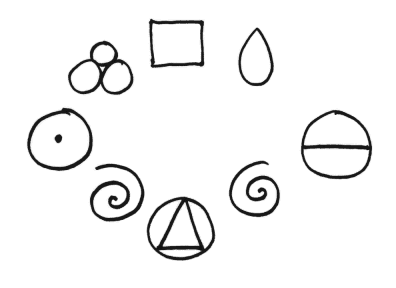| Manual Home | Manual Title | Manual Contents | Section Contents |
|
|
|
|
4. Calling the Circle
 In the past, when women lived close together in small
villages, it was common for their menstrual cycles to align. Women
were intimate with each other and also with the cycles of the earth.
Now there is a movement back to circle groups that give women the
opportunity to share some of the comforts and intimacy of early
villages. We have entered a time when women seem to intuitively
understand the value of returning to non-hierarchical circle groups
where intimacy comes naturally. Masks are removed, participants are
allowed—even encouraged—to be true to themselves. Participants
are comforted with the knowledge that they are accepted for who they
are rather than judged for what they have or have not done. A circle
is the place to be when your life seems to have become a succession of
fast-moving events that seem unrelated. Circle groups can help to
temporarily slow down the momentum allowing members to make sense of
the events in their lives.
In the past, when women lived close together in small
villages, it was common for their menstrual cycles to align. Women
were intimate with each other and also with the cycles of the earth.
Now there is a movement back to circle groups that give women the
opportunity to share some of the comforts and intimacy of early
villages. We have entered a time when women seem to intuitively
understand the value of returning to non-hierarchical circle groups
where intimacy comes naturally. Masks are removed, participants are
allowed—even encouraged—to be true to themselves. Participants
are comforted with the knowledge that they are accepted for who they
are rather than judged for what they have or have not done. A circle
is the place to be when your life seems to have become a succession of
fast-moving events that seem unrelated. Circle groups can help to
temporarily slow down the momentum allowing members to make sense of
the events in their lives.
Circle groups can be powerful. In circles, members learn each others’ strengths and weaknesses and members are, more or less, equals who are empowered to grow and change and to begin becoming the persons they most want to be. In circles, each member is encouraged to take responsibility for her own destiny.
Circle groups can be formed for support, ritual, therapy, or for any number of other purposes. It is important for groups to define their purpose before they form or while they are forming and also for members to consider how they will maintain their group. Does the group need or want a leader? Will members share in leadership? If the group has been formed for therapy, you will likely want a trained therapist or psychologist to help facilitate the group. UU women’s groups can easily support women’s support and ritual groups; women’s therapy groups require more expertise.